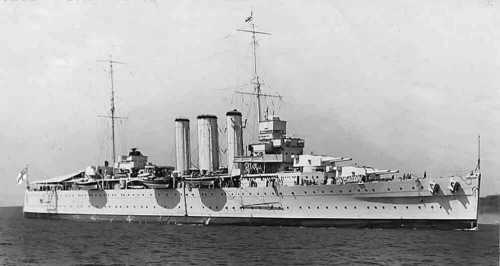
The heavy cruiser HMAS Australia (D 84) of the Royal Australian Navy.
Technical information
| Type | Heavy cruiser |
| Displacement | 9,750 BRT |
| Length | 630 feet (oa) |
| Complement | 679 men |
| Armament | Cornwall and Berwick in 1939;
8 8" guns (4x2)
8 4" AA guns (4x2)
16 2pdr AA (2x8)
8 0.5" AA (2x4)
3 aircraft
1 catapult
Cumberland in 1939; 8 8" guns (4x2) 6 4" AA guns (2x2,2x1) 8 2pdr AA (2x4) 8 0.5" AA (2x4) 3 aircraft 1 catapult Suffolk in 1939; 8 8" guns (4x2) 4 4" AA guns (4x1) 8 2pdr AA (2x4) 8 0.5" AA (2x4) 3 aircraft 1 catapult Kent in 1939; 8 8" guns (4x2) 4 4" AA guns (2x2,2x1) 8 2pdr AA (2x4) 8 0.5" AA (2x4) 8 21" torpedo tubes (2x4) 1 aircraft 1 catapult |
| Max speed | 31.5 knots |
| Engines | Geared turbines, 4 shafts |
| Power | 80,000 HP |
| Notes on class | The first RN Cruisers built within the confines of the Washington Naval Treaty of 1922, limiting standard displacement for heavy (8" gun) cruisers to 10,000 tons. Compared to other powers the 10,000 ton Kents were somewhat inferior in firepower and armour, but had an unrivalled radius of action of 10,400 miles at economy speed. They were designed for overseas service in peacetime and for hunting down commerce raiders in war on the long trade routes of the distant oceans. They were built to be lived in as well as fought and had sea keeping qualities and living standards unequalled before or since in any class of warship anywhere. Their high freeboard allowed for spacious decks, but they were inclined to roll. Throughout the 1930s they became a familiar sight over the vast stretch of territory from Batavia to Japan that comprised the China station. They were the emblem and the symbol of British supremacy in Hong Kong, and in the roads off the Shanghai and Hankow bunds they stood guard over the British presence. During the war they logged up immense distances and were to be found, in all the oceans of the world, encountering arctic blizzards, the doldrums of the tropic seas and everything in between. Ubiquitous as they were, they seldom made the headlines but played a part behind the scenes of vital consequence. The design was determined by the priorities of the main armament and speed, with a long hull and high freeboard to aid speed and secure seaworthiness. Side armour was abandoned to provide increased air defence with a protective deck. This was an improvement over earlier classes, but was still not effective against bombs. The height of the funnels were increased by 15ft following trials. Modifications shortly before WWII increased the displacement to 10,300 tons standard. The class was reconstructed between 1935 and 1938, with additional armour being installed and the anti-aircraft armament being improved. The after superstructure was replaced with a conspicuous large hangar for 3 amphibians, but not in Kent. Further additions during the war (including various combination of light AA guns) increased displacement to 10,900 tons standard and 14,500 tons full load. During 1942-1944 aircraft, catapult and hangers were removed. |
All ships of the Kent class
| ||
| HMAS Australia (D 84) | ||
| HMAS Canberra (D 33) | Lost on 9 Aug 1942 | |
| ||
| HMS Berwick (65) | ||
| HMS Cornwall (56) | Lost on 5 Apr 1942 | |
| HMS Cumberland (57) | ||
| HMS Kent (54) | ||
| HMS Suffolk (55) | ||
Full wartime service history on this vessel. | ||
See all Heavy cruiser classes.
|
Books dealing with this subject include:
|
